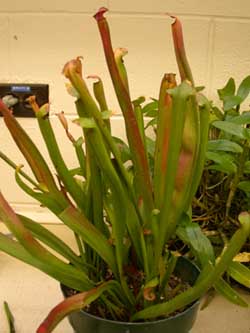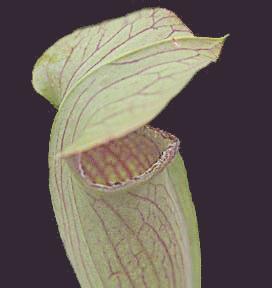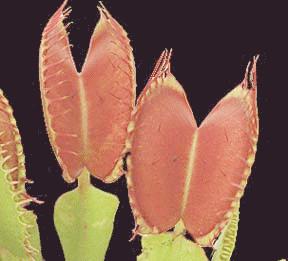NITROGEN DEFICIENCY
In some habitats nitrogen is not readily available to plants.
Some plants solve the problem of the lack of available nitrogen in a very aggressive fashion. The carnivorous, or insect-eating plants, have leaves modified to attract and trap animal prey and utilize animal proteins directly as a nitrogen source. As you look at the images of insectivorous plants think about how the leaves are modified to perform the functions of trapping and digestion.
Sarracenia
(Pitcher Plant)
The leaves of this plant are upright and flask-shaped.
Numerous nectar-secreting glands on the outer surface, and especially around the lip of the flask, serve to attract insects. The red or purple colouration of some flasks may also be attractive to insects. Once the insects enter the pitcher they are prevented from getting out by a combination of downward-pointing hairs and a slippery surface. Trapped insects eventually drown in fluid at the bottom of the pitcher, and are digested by enzymes secreted into the fluid.
Linda is finding a yummy morsel from inside the trap. I guess if you are a starving TA the little trapped bugs might be a treat!
Dionaea (Venus Flytrap)
Nectar is secreted on the leaf surface of the Flytrap. Each leaf has a broad petiole and a leaf blade of two halves, which are joined by a moveable hinge. The edges of the blade bear stiff bristles and in the middle of each half are three long trigger hairs.
When an insect touches the trigger hairs, the two halves quickly close and trap the insect. The movement is caused by differential cell enlargement on the outer leaf surface. As in the pitcher plant, digestive enzymes are then secreted, and nutrients are absorbed by the plant. Several days later the blade again opens, ready to trap another insect.
In addition to the trigger hairs, note the pink secretory cells on the leaf surface. These are the source of the enzyme which digests the trapped insect.
Drosera (Sundew)
Sundews are lovely little bog plants.
The surface of the Sundew leaf is covered with many tentacle-like hairs, each with a rounded glandular head and an internal strand of xylem. The gland secretes a sticky mucilage which is attractive to insects. When an insect becomes entangled by the mucilage, the tentacles bend inward. Nearby tentacles also bend towards the insect, as may the entire leaf, entrapping the prey. The movement of the tentacles, like the movement of the flytrap leaf, is the result of rapid differential cell enlargement.
Here is a longitudinal section through. A leaf with tentacles.
Utricularia vulgaris (Bladderwort)
This aquatic plant traps and digests insects and other organisms within small hollow bladders. The bladder entrance is covered by a door which is hinged at the upper edge and has stalked mucilage glands to produce attractive substances, and stiff bristles to act as a tripping mechanism. The bladder empties itself by excreting water, thus creating pressure on its walls from the water outside. When prey touches the bristles, the edge of the door opens a crack, allowing water to rush into the trap, carrying the helpless insect with it. Enzymes secreted within the bladder digest the insect. The walls of the bladder absorb the nutrients released.
Pinguiculaa (butterwort)
The leaves of this plant are slimy (hence the name “butterwort”). If you were to look at the leaf microscopically you would see two types of glands – those which produce a sticky suubstance (to catch the insect) and digestive glands (to release enzymes). The flowers are often borne a distance from the insect catching part of the plant…pretty smart! You wouldn’t want to eat your pollinators!
Some plants overcome nitrogen deficiency by developing symbiotic associations with nitrogen-fixing bacteria or cyanobacteria.
Azolla
This fern, Azolla, has a symbiotic association with the cyanobacterium Anabaena.
Gunnera
Gunnera (elephant ear plant) has colonies of Nostoc (another cyanobacterium) living in the bases of its leaf petioles.
CARNIVOROUS PLANTS – for a more indepth look at this plant adaptation.
NITROGEN DEFICIENCY














